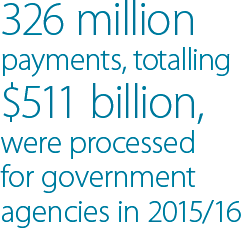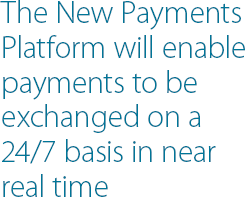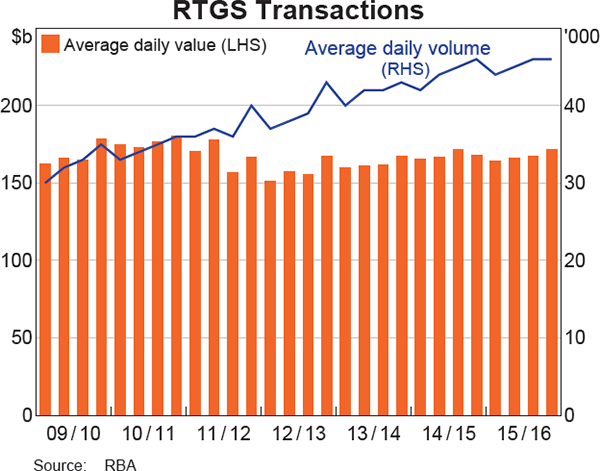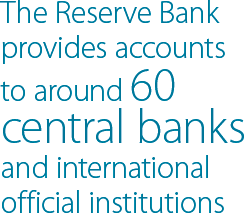Reserve Bank of Australia Annual Report – 2016 Banking and Payment Services
The Reserve Bank provides important banking and payment services that underpin the efficient and stable functioning of the Australian financial system. The Bank is currently developing new banking and settlement capabilities and new infrastructure to support real-time settlement of payments by Australian households and businesses. This will ensure that the Bank continues to meet the needs of its government and agency customers and, in turn, the public.
Banking
The Reserve Bank's banking services comprise two broad components: core and transactional banking services. Both are provided with the objective of delivering secure and efficient arrangements to meet the banking and payment needs of the Australian Government and its agencies. In addition, the Bank provides banking and registry services to a number of overseas central banks and official institutions.
Core banking services are provided to the Department of Finance and the Australian Office of Financial Management (AOFM). These services derive directly from the Reserve Bank's role as Australia's central bank and require the Bank to manage the consolidation of Australian Government agency account balances – irrespective of which financial institution each agency banks with – into the government's Official Public Accounts (OPA) at the Bank on a daily basis. Balances from agencies' accounts at transactional banks are ‘swept’ to the OPA at the end of each business day, with balances required to meet agencies' day-to-day payment obligations returned the following morning. The average daily sweep to and from the OPA was around $3 billion in 2015/16.
The Reserve Bank also provides the government with a term deposit facility for investment of its excess cash reserves, as well as a limited short-term overdraft facility to cater for occasions when there is unexpected demand on government cash balances. The overdraft facility was not accessed during the past financial year.
While the Reserve Bank manages the consolidation of the government's accounts, the AOFM has day-to-day responsibility for ensuring there are sufficient cash balances in the OPA to meet the government's day-to-day spending commitments and for investing excess funds in approved investments, including term deposits with the Bank.
The Reserve Bank's transactional banking services are associated with more traditional banking activities. Principal among these are services for making payments from government agencies to recipients' accounts. The Bank processed some 326 million payments, totalling $511 billion, for government agencies in 2015/16. Most of these were made via direct entry. The Australian Government also makes payments by eftpos, the real-time gross settlement (RTGS) system and cheque, though its use of cheques has fallen significantly in recent years. Cheques now make up less than 2 per cent of agency payments, compared with around 10 per cent 15 years ago. The decline reflects concerted action by agencies to reduce their use of paper-based transactions for which processing costs are higher and have steadily increased. In addition to payments, the Bank provides its government agency customers with access to a number of services through which they can collect funds, including Electronic Funds Transfer, BPAY, eftpos and card-based services via phone and online. The Bank processed 31 million collections-related transactions for the Australian Government in 2015/16, amounting to $467 billion.

Transactional banking services have been a longstanding part of the Reserve Bank's responsibilities under the Reserve Bank Act 1959, which requires the Bank to provide these services to the Australian Government if so required. These services are offered in line with the Australian Government's competitive neutrality guidelines. To deliver the services, the Bank competes with commercial financial institutions, in many instances bidding for business at tenders conducted by the agencies themselves. The Bank must also cost and price the services separately from its other activities, including core banking services, and meet a prescribed minimum rate of return. Some 90 government agencies are transactional banking customers of the Bank. Pro forma business accounts for transactional banking are provided in this report, on page 127.

The Reserve Bank works closely with its transactional banking customers and with the Australian Government more generally to ensure that they have access to services that meet their needs and those of the public. In 2015/16, the Bank introduced a ‘tokenisation’ feature to enhance security for users of its online payments service, Government EasyPay. The feature allows the Bank's agency customers to offer a broader range of card payment services to entities using Government EasyPay without the need for agencies to store card-related information. For some services, the Bank combines its specialist knowledge of the government sector with specific services and products from commercial providers to meet the government's banking needs. The Bank will continue to make use of combined service arrangements with commercial providers as the government's banking needs evolve.
Registry services are also provided by the Reserve Bank to supranational organisations issuing Australian dollar-denominated securities. Nine organisations currently use these services. The number has remained relatively steady over the past few years.
In common with other financial institutions, the Reserve Bank relies heavily on information and communications technology systems to deliver banking services to its customers. The Bank needs to upgrade and improve its systems over time to ensure that they continue to provide the highest levels of service, reliability and efficiency. Annual reports for the past few years have noted that the Bank is undertaking a significant program of work to upgrade its banking systems, moving them to a more user-friendly programming language and architecture and re-engineering a number of related business processes. Further milestones in the program were achieved during 2015/16. In particular, an upgrade of the system by which the Bank processes the government's international payments was completed in October 2015, while the second of three services by which the Bank processes payments to its agency customers was completed in May 2016. Work also began in late 2015 to select a third-party provider to replace the Bank's system for maintaining customers' accounts. Initial stages of this work are expected to be completed during 2016/17, with the new account maintenance system scheduled to be fully operational by late 2018.

During 2015/16, the Reserve Bank also continued its contribution to developing the payments industry's New Payments Platform (NPP), which will enable payments to be exchanged on a 24/7 basis in near real time together with more complete remittance information. Also, as part of this contribution, work is under way within the Bank to implement a system to process government-related transactions across the new platform. The Bank expects to make an NPP service available to its agency customers from the payments industry's scheduled go-live date in the second half of 2017. In common with the program to upgrade the Bank's banking systems, the work in the Bank is being overseen by a Steering Committee comprising senior staff. Further information on the NPP is available below in the section on Settlement Services.
After-tax earnings from the Reserve Bank's transactional banking services were $6 million in 2015/16, $0.5 million higher than in the previous year. The increase was largely due to increased transactions through the Bank's online collection services. This was tempered slightly by higher costs associated with systems development and service improvements.
Settlement Services
The Reserve Bank Information and Transfer System (RITS) is Australia's high-value payments system, which settles payment obligations across Exchange Settlement Accounts (ESAs) held at the Bank. RITS provides the irrevocable settlement of transactions in real time using central bank money and constitutes a critical part of Australia's financial system. At the end of June 2016, there were 170 RITS members, of which 60 were directly operating an ESA for settling payment obligations. It is mandatory for all Australian banks to hold an ESA. ESAs must also be operated by institutions that reach certain transaction thresholds. Certain financial market infrastructure entities deemed systemically important are also required to hold an ESA.
Most RITS transactions are settled individually on a RTGS basis, removing the settlement risk inherent with deferred settlement. Transactions settled in real time include high-value customer, corporate and institutional payments, wholesale debt securities transactions and foreign exchange transactions. On average, 45,000 RTGS transactions, worth $167 billion, were settled each day in 2015/16 using the system. RTGS volumes have been trending upwards over the past several years, but growth slowed somewhat in 2015/16. During the same time period there was little change in RTGS values.
RITS also settles some payments on a net deferred basis. This allows for more efficient use of liquidity because transactions between ESA holders can be netted, but it can also introduce some degree of settlement risk. Payment obligations arising from cheques and some retail cards are settled on a multilateral net basis at around 9.00 am on the day following clearing. Most obligations arising from direct entry payments settle shortly after official industry clearing exchange times, in five multilaterally netted batches each day. During 2015/16, the average daily value of all net retail obligations settled in these six multilateral batches was $7.7 billion, corresponding to gross underlying transactions worth more than $23 billion.
There are three additional arrangements for settling batches of payments netted outside RITS. One of these arrangements is the daily CHESS batch, managed by ASX Settlement Pty Limited, which provides for the settlement of obligations arising from equity market transactions. In 2015/16, the average daily CHESS batch settlement value was $1.0 billion. A second arrangement provides for the settlement of obligations arising from domestic MasterCard transactions. MasterCard International has been a Batch Administrator since late 2014, with the daily value of its multilaterally netted batches averaging $488 million in 2015/16.

The third batch feeder arrangement in RITS is operated by Property Exchange Australia Limited (PEXA). Commencing in late 2014, this arrangement is part of a national electronic conveyancing system and provides for settlement of interbank cash payments related to some property transactions. Since going live in November 2014, gross settlement value in the PEXA batch has recorded a 26 per cent compound monthly growth rate, with average daily values tripling during 2015/16. More than $33 billion of transactions have now been settled through this facility, with the average daily value of transactions increasing to $197 million in June 2016.
The program to develop the NPP is a significant collaborative undertaking by payments service providers, which is expected to be completed towards the end of 2017. The NPP will allow authorised deposit-taking institutions to send real-time, data-rich payments on a 24/7 basis for households, businesses and government agencies. It will also provide more user-friendly ways to address payments, for example through the use of mobile phone numbers and email addresses. The Reserve Bank is actively participating in the broader NPP program and is also building the RITS Fast Settlement Service (FSS), which will settle NPP payments individually in real time. The FSS has been designed for high performance and high availability. Payments settled through the FSS will be final and irrevocable, enabling financial institutions to provide for immediate funds availability to customers without incurring credit risk.

RITS is a systemically important part of the Australian financial system and as such is designed to be a highly resilient system, with critical infrastructure duplicated in two geographically separate sites. RITS is benchmarked against internationally agreed standards and the resilience of its infrastructure is assessed annually against the Principles for Financial Market Infrastructures (PFMI) developed by the Committee on Payments and Market Infrastructures (CPMI) and the Technical Committee of the International Organization of Securities Commissions (IOSCO). The 2015 PFMI assessment by the Reserve Bank concluded that RITS adhered to all relevant principles and noted the Bank's ongoing program of work to strengthen further the security and resilience of RITS.[1] This work program includes reviews of existing security controls, recovery options and the payments contingency arrangements that could be used if RITS was unavailable for an extended period. The Bank will continue its work to ensure its infrastructure is resilient against cyber attack and to enhance its ability to resume critical settlement operations safely in the event of an operational incident.

RITS is run on a cost-recovery basis, with the Reserve Bank charging members a combination of annual and transaction-based fees. Over the past several years costs have increased, mainly because of rising technology costs. The fee structure of RITS is assessed regularly and adjusted to ensure an equitable and representative distribution of fees among members.
The Reserve Bank provides accounts to around 60 central banks and international official institutions to allow for settlement of their Australian dollar transactions. Around half of these overseas official sector agencies also make use of safe custody services offered by the Bank. At the end of 2015/16, the face value of securities held in custody by the Bank in this capacity exceeded $72 billion. The Bank also provides settlement services for banknote lodgements and withdrawals by commercial banks.
Footnote
For further detail, see Reserve Bank of Australia (2015), ‘2015 Assessment of the Reserve Bank Information and Transfer System’, November. [1]